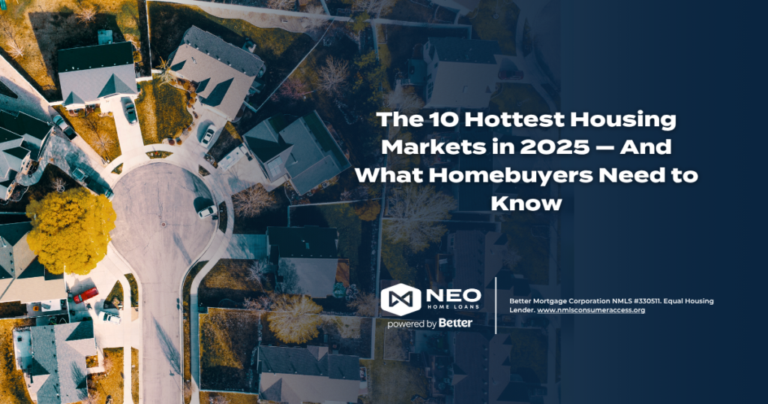
The 2023 housing market was nothing short of remarkable.
Mortgage interest rates kept climbing. The higher they went, the more buyers were priced out, especially first-timers. Meanwhile, the housing shortage didn’t improve as the higher rates resulted in more would-be sellers deciding to stay put and hold onto their low mortgage rates.
Not surprisingly, the number of existing-home sales dropped in 2023 as the market contracted. Sales fell nearly 19.1% from 2022 and about 33.5% from 2021, according to Realtor.com.
2023 is on track to have the fewest existing-home sales since 1995! That’s despite all of the pent-up demand from aspiring buyers eager to get into a home of their own.
So what happened in 2023 that caused all this turmoil with housing? Let’s look back on the changes the defined the year.
High mortgage rates paralyzed the market
The high mortgage rates that wreaked havoc on the housing market were a byproduct of the U.S. Federal Reserve hiking up its short-term interest rates to combat inflation. When the Fed jacked up its rates, mortgage rates generally followed, although they were volatile throughout 2023.
The year kicked off with mortgage rates in the mid-6% range, according to data from Optimal Blue. That was a promising start to the new year as rates had topped 7% in fall 2022 before coming down.
But that relief was short-lived. By early March of 2023, rates had passed 7% once again. They moved up and down throughout the year and topped out at nearly 8% at the end of October.
This was when the Federal Reserve finally became optimistic about inflation and decided to pause their aggressive rate-hiking policy. The bond markets reacted favorably to this news, and mortgage rates finally started to trickle down.
Rates dropped even more in December after it was announced that several cuts to the fed funds rate are anticipated in 2024. As of the publishing of this article, the average 30-year fixed rate is nearly 6.5% according to data from Optimal Blue.
New listings dried up
As rates continued to climb, the number of existing homes going up for sale fell dramatically.
This contributed to what many call the “lock-in effect”. Today’s homeowners have such low mortgage rates that they either won’t sell or they simply can’t sell and take on a more expensive housing payment at a higher rate.
And this isn’t just a small number of homeowners. Nearly two-thirds of all mortgages out there today have an interest rate below 4%, and nearly a quarter have a mortgage rate below 3%. Most of these homeowners will not budge and will continue to enjoy their low, fixed-rate mortgage for many years to come.
Home prices hit all-time highs once again
Many housing experts thought that 2023 was going to be the year that home prices finally tumbled down. They had risen so much over the past few years and, combined with higher mortgage rates, they strained the budgets of buyers.
But while the double-digit price increases experienced during the COVID-19 pandemic came to an end, prices this year still edged up.
The median home price dared to go up 2.1% year over year, to $428,000 in 2023. (The data is from January through November using the most recent Realtor.com listing data.) That’s a new record.
That’s because buyers were still forced to compete for a very limited supply of homes for sale. So when a move-in ready home in a desirable area came on the market at a relatively affordable price, buyers bid up the price in multiple-offer situations.
Prices started at a median of $403,333 in January and steadily rose in the first half of the year. They peaked at $445,000 in June. As they often do in the colder months, prices fell and hit $420,000 by November, according to the most recent Realtor.com data.
First-time homebuyers were affected the most by the combination of high prices and mortgage rates. They couldn’t use the proceeds from a previous sale to finance the next one. And as they tend to be younger, they often don’t yet earn the higher salaries that could help them compete with repeat buyers and investors.
New home construction continued to fall behind
New construction increasingly became a lead player in the 2023 housing market. Too bad there wasn’t enough of it to go around.
When buyers couldn’t find homes on the resale market, they turned to the builders who found ways to put up smaller, more affordable homes this year. Many of the larger builders were able to contribute to buyers’ closing costs, offer upgrades, and buy down mortgage rates (for either the first few years of a buyers’ loan or the full term).
However, the number of housing starts dropped about 10% in 2023 compared with the previous year, according to the National Association of Home Builders. (Housing starts are a measure of homes that builders have begun construction on but have not yet completed.)
Builders began 2023 strong but waned in the second half of the year.
The number of new apartment buildings going up also dipped as higher interest rates made it harder for builders to obtain financing in the second half of the year. Apartment construction remained strong in the outer suburbs and rural markets, but it fell in big cities and was flat in close-in suburbs.
What’s in store for 2024?
We may be in the thick of winter, but many homebuyers and sellers are starting to have warm thoughts about the housing market. That’s because, looking ahead, market indicators suggest we’ll see increased activity thanks to lower mortgage rates. Yet home prices remain high and inventory levels are tight in many markets.
How will the first part of 2024 shake out when it comes to rates, prices, sales activity and more? Keep a look out for our 2024 Housing Market Predictions to be released next month!










